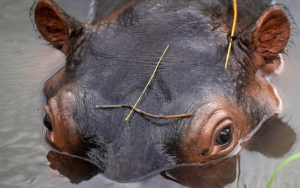Invasive species are a huge problem to local ecosystems, as they usually mess with the flow of the environment, often at the expense of their adoptive environments. More  often than not, the animals in question are smaller creatures, such as toads, turtles or other such animals. Yet sometimes, the problem is a lot bigger. I recently came across an article about a problem in Colombia’s rural Antioquia Department: the hippopotamus. How, might you ask, did such massive animals originally from thousands of miles away make it to rural Colombia? The creatures came from the private zoo at Hacienda Napoles, the private compound of late drug baron Pablo Escobar. After he made his millions, Escobar smuggled in various exotic animals, including four hippopotami, into Colombia for his private zoo. After Escobar’s death, Hacienda Napoes was confiscated by the Colombian government, and Escobar’s menagerie was dispersed to zoos around the country. That is, except for the hippos.
often than not, the animals in question are smaller creatures, such as toads, turtles or other such animals. Yet sometimes, the problem is a lot bigger. I recently came across an article about a problem in Colombia’s rural Antioquia Department: the hippopotamus. How, might you ask, did such massive animals originally from thousands of miles away make it to rural Colombia? The creatures came from the private zoo at Hacienda Napoles, the private compound of late drug baron Pablo Escobar. After he made his millions, Escobar smuggled in various exotic animals, including four hippopotami, into Colombia for his private zoo. After Escobar’s death, Hacienda Napoes was confiscated by the Colombian government, and Escobar’s menagerie was dispersed to zoos around the country. That is, except for the hippos.
For about 20 years now, the hippos have remained in their adopted Colombian home, thriving and multiplying. Nobody knows how many hippos there are in the area. The local environmental authority estimates that their numbers range between 50 and 60, most of whom live in the lake at the park. However, 12 are known to have paddled past the park’s flimsy fence and into the Magdalena River, which has proven as idyllic conditions for hippos. The river is slow-moving and has plenty of shallows, making it perfect for larger animals (such as hippos). The region also never experiences drought, which typically works to keep the population of hippos in Africa in check. The environment is actually so great for the hippos that they’ve even started to reproduce at higher rates (and younger ages) than their cousins across the Atlantic Ocean. All of the fertile females have been reported as giving birth to a calf every year.
The hippos have been found up to 155 miles away from Hacienda Napoles. Not without good reason, fishermen are terrified of the creatures, and they roam the countryside at night, eating crops and even killing cows. Despite their goofy appearance, hippos are extremely dangerous animals, highly territorial and capable of charging on land at up to 18 mph. It’s estimated that hippos are responsible for more deaths in Africa than any other wild mammal. Yet in Colombia, they view them as more “cuddly”, with children swimming with the animals and some people even bringing calves home. Attacks on humans typically occur when humans encroach on hippo territory, although hippos don’t instinctively want to kill something when they see it, like crocodiles. Therefore, in a sparsely-populated area like rural Antioquia, it might be safer to just let the hippos be. In the 30 years that the animals have been in Colombia, there haven’t been any reports of anybody being killed or even seriously injured by the beasts.
The ideal situation would be to relocate them, although moving a hippo isn’t terribly easy. They can’t be returned to Africa because they might be carrying diseases, so bringing them to zoos is the only real solution. However, while some calves have been taken to zoos, nobody wants the adult hippos. Some have suggested containing numbers by neutering males, although this would be costly, dangerous and potentially cause the chemically sensitive hippos to die. Other suggestions include building proper hippo-proof fences to contain the animals in a reservation, although rounding up all of Colombia’s feral hippos would be a costly and difficult task. Even more drastic suggestions have included eating the animals; when one hippo was killed in an electric fence a few years back, some locals ate him, claiming that he tasted similar to pork (hippos are known to be related to pigs). Nonetheless, hippo meat could be infected, and systematically killing hippos would be an international PR nightmare. Back in 2009, Colombia shot and killed one bull hippo that had been deemed a “public nuisance”, a photograph of soldiers posing next to the animal’s body caused a public outcry.